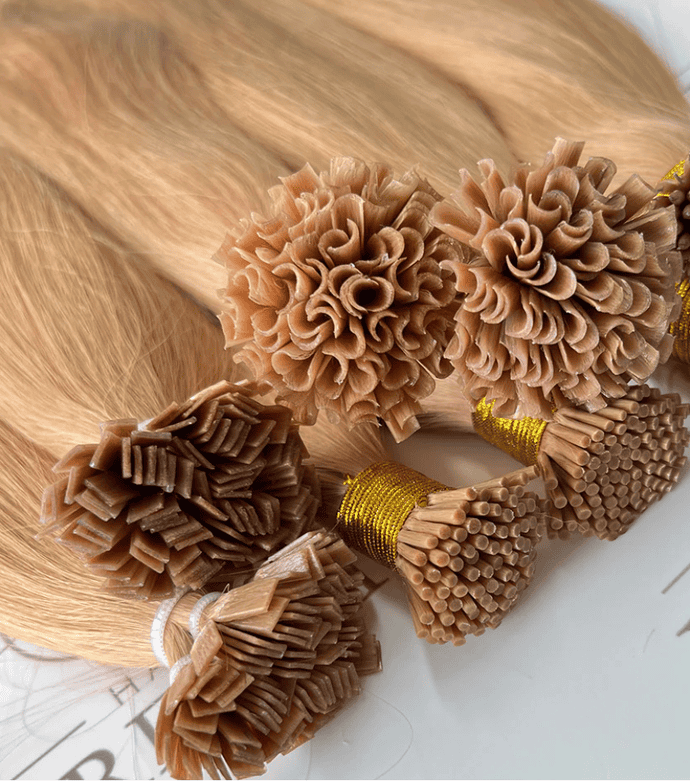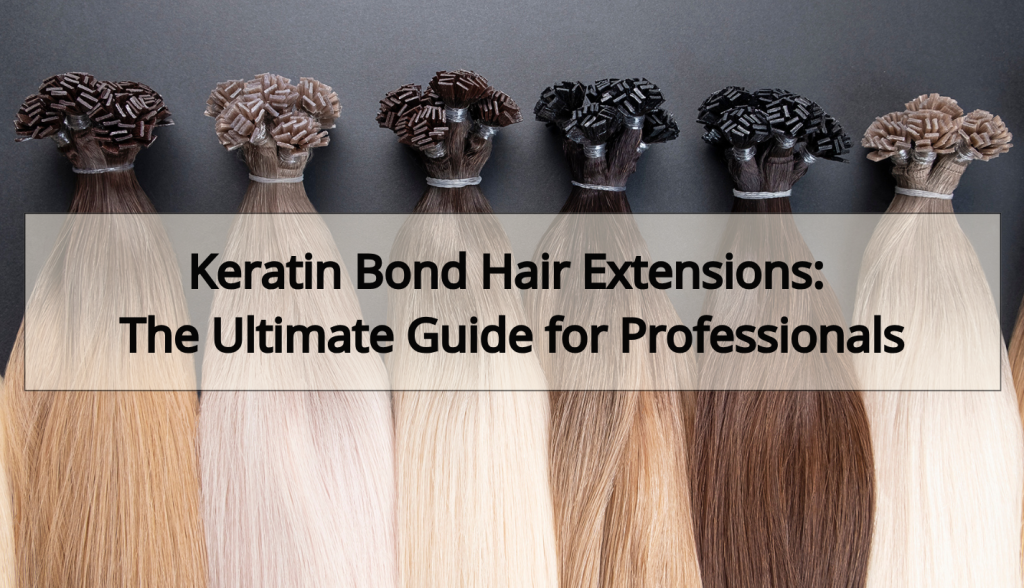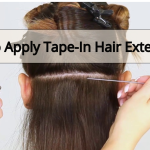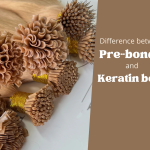Hair Knowledge
Keratin Bond Hair Extensions: The Ultimate Guide for Professionals
I. What Are Keratin Bond Hair Extensions?
1. Definition
Keratin bond hair extensions—also known as fusion hair extensions—are one of the most durable and discreet methods of semi-permanent hair enhancement. They are a top choice for professional stylists and clients who want long-lasting, natural-looking volume and length without daily attachment.
Despite the name, the term “keratin” here refers not to the natural protein found in hair, but to a specialized adhesive polymer that mimics keratin in appearance and flexibility. It is designed to melt under heat, bond securely to natural hair, and hold extensions in place for several weeks.
2. Key Characteristics of Keratin Bond Hair Extensions
Keratin bond hair extensions offer a high-end solution for clients seeking longevity, comfort, and a seamless blend. Here’s what makes them stand out from other application methods:
Long-Lasting Hold (8–12 Weeks)
When applied by a trained professional and maintained properly, keratin bonds can last two to three months—making them ideal for clients who prefer low-maintenance yet long-term extensions. Some clients can even extend wear to 14 weeks with regular salon checks and proper aftercare.
💡 Note: Duration may vary depending on hair growth rate, oil production, and daily routine (e.g., swimming, styling frequency).
Nearly Invisible Bond Points
The small, clear or lightly tinted keratin tips melt and wrap tightly around natural hair, forming tiny bonds that lie flat against the scalp. Unlike clip-ins or bulky wefts, these bonds are virtually undetectable—even when the hair is worn up or parted in different directions.
Especially suitable for clients with fine or thin hair, where discretion is key.
Lightweight and Comfortable
Each bond is applied to a very small section of natural hair, spreading weight evenly across the scalp. When done correctly, keratin extensions don’t pull or cause strain, making them more comfortable for long-term wear than heavy sew-ins or tape-in rows.
Versatile Styling Options
One of the top advantages of keratin bonds is their 360° flexibility:
- High ponytails and buns
- Braids and updos
- Straightening or curling with heat tools
The bonds move naturally with the hair and are invisible from all angles, giving clients full styling freedom without awkward bumps or gaps.
Customizable for Every Hair Type
Keratin bonds can be cut into micro-sections, used for full-head installations, or applied in small patches to fill in sparse areas or add highlights (without bleach). They are particularly effective for:
- Filling thinning temples or front sections
- Blending blunt haircuts
- Adding length without overloading fine strands
Reusable (in some cases)
While keratin bonds are typically designed for single use, some stylists reuse the hair by removing the old bond, cleaning the strand, and re-tipping it with new keratin. This requires additional time and equipment but is often worthwhile for high-quality virgin hair.
⚠️ Re-tipping should only be done by experienced technicians.
Safe When Applied Properly
Despite involving heat, the process is scalp-safe and causes no damage when:
- Heat tools are used at the right temperature (usually 180–220°C)
- Proper spacing is maintained from the scalp
- Remove bonds professionally with a keratin-dissolving solution
3. Structure of a Keratin Bond Extension
Each keratin bond extension is meticulously crafted to ensure a secure, invisible, and comfortable attachment to the client’s natural hair. While simple in form, its structure is the result of a carefully engineered balance between strength, flexibility, and compatibility with different hair types.
A standard keratin extension consists of two main components:
A. 100% Human Hair Strand
This is the primary part of the extension—the hair itself. In premium-grade products, this hair is:
- Ethically sourced from donors, often from Southeast Asia (e.g., Vietnam, India)
- Remy-aligned, meaning the cuticles run in the same direction, minimizing tangling
- Virgin (optional), untreated and free from chemical processing for optimal strength
✳️ Available Features:
- Lengths: Typically from 14” to 30” (customizable)
- Colors: Natural shades (1B, 2, 4) or pre-dyed to ash blonde, copper, platinum, etc.
- Textures: Straight, body wave, deep wave, kinky curly, and more
- Quality Tiers:
- Single Drawn: Natural taper from root to tip
- Double Drawn: Consistent volume throughout
- Super Double Drawn: Maximum thickness from top to bottom (ideal for European salons)
- Single Drawn: Natural taper from root to tip
💡 Note for stylists: Always match the texture and density of the extension to your client’s hair for the most seamless result.
B. Keratin Bond Tip (The Attachment Base)
This is the small adhesive tip at the root end of the hair strand, designed to be melted and bonded to natural hair using heat. Despite the name, this “keratin” is a custom-formulated synthetic polymer, not the biological protein.
📌 Key Elements of the Bond Tip:
| Aspect | Details |
| Material | Thermoplastic adhesive polymer (keratin-like compound) |
| Shape options | U-tip (nail tip), V-tip, I-tip, flat-tip |
| Size | Typically 0.8–1.2 cm wide and 1–2 mm thick (customizable) |
| Melting point | Between 180–220°C depending on brand and hardness level |
| Color | Clear, dark brown, or blonde (to match client hair tone) |
| Flexibility | Soft and pliable once melted, hardens securely once cooled |
| Bond weight | 0.6g–1g per strand (adjustable based on density and install method) |
Common Tip Shapes Explained:
- U-Tip (Nail Tip): Most widely used in salons; shaped like a small “U” that wraps around the natural hair strand
- V-Tip: Similar to U-tip but slightly narrower, used for micro-section installs or finer hair
- Flat-Tip: Flattened bond for a low-profile appearance; lays flush with the scalp
- I-Tip (if fused with heat): Can also be used with keratin, though more often applied with beads

🔍 Each bond type is selected based on the stylist’s technique and the client’s hair density, lifestyle, and styling goals.
How Is the Keratin Bond Formed?
- A small amount of thermoplastic is heated and formed around the hair bundle
- It’s cooled into a solid, pre-molded tip
- Sometimes texturized or scored to enhance adhesion
- Stored with a protective coating or sleeve to maintain integrity until use
✅ Structural Summary
|
Component |
Purpose |
| Human hair strand | Provides volume, length, or color effect |
| Keratin bond tip | Connects the extension to natural hair via heat fusion |
| Shape & size | Designed for flexibility, durability, and near-invisibility |
| Material safety | Hypoallergenic, non-toxic, tested for use near the scalp |
💡 Note: Well-constructed keratin extensions should never feel stiff, bulky, or sticky.
II. Types of Keratin Bond Extensions
Keratin bond extensions are broadly categorized by their application method—how the bond is attached to the natural hair. There are two main techniques:
- Hot Fusion: Uses heat to melt the keratin tip and fuse it directly to the hair
- Cold Fusion: Bonds the extension using ultrasound or mechanical pressure, without high heat
Each method has its own benefits and is suited to different hair types, client preferences, and salon setups.
1. Hot Fusion Keratin Extensions
🔍 What is Hot Fusion?
Hot fusion is the traditional keratin bonding method. It involves melting the keratin tip with a heated applicator tool, then molding it around a small section of the client’s natural hair. Once cooled, the bond hardens, securing the extension in place.
✅ Wear time: 8–12 weeks
✅ Best for: Clients wanting strong, long-lasting hold with full styling freedom
📌 Most Common Hot Fusion Types:
1.1 U-Tip (Nail Tip) Extensions
Structure:
- U-shaped keratin tip
- Wraps around the natural strand when heated
- Most widely used hot fusion method in salons
Advantages:
- Strong and durable
- Works well on thick or coarse hair
- Excellent for full-head installations
Considerations:
- Requires precision and training
- Best removed with acetone-based keratin remover
1.2 V-Tip Extensions
Structure:
- Narrower than U-tip
- Designed for smaller, more delicate sections
Advantages:
- Suitable for clients with finer or thinner hair
- Lighter bond for added comfort
- Allows greater flexibility near hairline or temples
1.3 Flat-Tip Keratin Extensions
Structure:
- Flat, paddle-like tip
- Lays flush against the scalp
Advantages:
- Ultra-invisible
- Comfortable for side parts or updos
- Spreads weight evenly, reducing stress on hair roots
Considerations:
- May require extra care during removal
- Best suited for clients with fine to medium hair
1.4 Custom-Tipped Extensions
Some manufacturers offer custom re-tipping where hair is tailored with a specific bond shape, color, or size to match your installation style.
2. Cold Fusion Keratin Extensions
🔍 What is Cold Fusion?
Cold fusion is a non-thermal bonding technique that uses ultrasonic vibration or compression to activate a keratin-based adhesive without heat. This method is ideal for clients with sensitive scalps or fragile hair prone to heat damage.
✅ Wear time: 8–10 weeks
✅ Best for: Fine, damaged, or chemically treated hair
📌 Common Cold Fusion Methods:
2.1 Ultrasonic Cold Fusion Extensions
How it works:
- Uses an ultrasonic applicator to vibrate the keratin polymer into a softened state
- Extension bonds form without direct heat
Advantages:
- Gentle on natural hair and scalp
- Suitable for bleached, colored, or fragile hair
- Creates smaller, flatter bonds for invisible finish
Considerations:
- Requires specialized equipment
- More time-consuming than hot fusion
- Higher cost per session
2.2 Micro Keratin Cold Fusion (Soft Bond)
Structure:
- Uses a gel-like soft bond activated by mechanical pressure or low heat
- Flexible and soft to the touch
Advantages:
- Comfortable and lightweight
- Ideal for blending around the face or crown
- Easier removal with minimal residue
Best for:
- Clients with hair breakage concerns
- First-time extension wearers who want a gentler method
2.3 I-Tip Extensions (Stick Tip Extensions)
Structure:
Individual strands of hair are tipped with a small, cylindrical keratin coating (stick tip). Each strand is inserted into a silicone-lined micro ring or nano ring and clamped shut with pliers—no heat or glue required.
Advantages:
- Heat-free and chemical-free application
- Reusable strands—simply replace the beads
- Allows for natural hair movement and versatile styling
- Ideal for customizing placement and density
Considerations:
- Application is more time-consuming (2–3 hours for full head)
- May slip if not properly maintained or on oily scalps
- Beads may be slightly visible in very fine or thin hair
- Requires installation tools (loop tool, pliers, bead organizer)
Comparison Table: Hot Fusion vs. Cold Fusion
| Feature | Hot Fusion | Cold Fusion |
| Application Tool | Heat connector (180–220°C) | Ultrasonic tool / mechanical clamp |
| Best for | Normal to thick, healthy hair | Fine, fragile, or processed hair |
| Installation Time | 2–3 hours (full head) | 3–4 hours (slower process) |
| Styling Versatility | Excellent – full flexibility | Excellent – flat, hidden bonds |
| Comfort & Sensitivity | Moderate (due to heat) | High – no heat, scalp-friendly |
| Bond Size | Small to medium | Micro-bonds available |
| Equipment Cost | Low to moderate | High (ultrasonic machine required) |
| Price Point | Medium | High |
💡 Tip for salons: Offering both fusion methods gives your clients more control over comfort, longevity, and aesthetics—especially important in European markets with diverse hair types and high demand for customization.
III. Production Process & Bonding Techniques of Keratin Extensions
Keratin bond hair extensions are one of the most technically precise and labor-intensive types of human hair extensions. From hair selection to tip molding, every step is carefully managed to ensure high performance, safety, and longevity. This section breaks down the typical manufacturing and application process followed by top-tier suppliers.
1. Manufacturing Process
🔹 Step 1: Raw Hair Selection & Preparation
- Hair sourcing: High-quality virgin or Remy human hair is collected, often from Vietnamese, Indian, or Slavic donors.
- Alignment: The cuticles are kept intact and aligned in one direction to prevent tangling.
- Cleaning: Using sulfate-free and chemical-free methods to gently wash and sanitize the hair
- Sorting: Sort hair by length, texture, color, and thickness to ensure uniform bundles.
Premium-grade factories avoid chemical stripping or acid baths to maintain natural integrity and strength of the hair.
🔹 Step 2: Drawing & Texture Treatment
- Hair is drawn into:
- Single drawn: Natural thickness from root to tip
- Double drawn: Manually sorted for full volume
- Single drawn: Natural thickness from root to tip
- Textures such as straight, body wave, or curly are set using steam or heat-based methods (never chemical perms in high-end products).
🔹 Step 3: Bond Tip Formation
Each bundle of hair is sectioned and bonded at the root using thermoplastic resin:
- A small amount of keratin adhesive is melted
- Dip or shape hair into the desired tip (U, V, flat, I-tip)
- Cool and trim the tip for uniformity
- Customizations like bond size, bond color, or weight are applied depending on client or distributor specifications
Pro suppliers use medical-grade keratin to reduce allergic reactions and ensure heat tolerance without burning.
🔹 Step 4: Quality Control
Every bundle is manually inspected for:
- Shedding resistance
- Tangle-free quality
- Bond integrity and consistency
- Color accuracy and root-tip alignment
Extensions are packaged in breathable bags or protective boxes and prepared for export.
2. Application Techniques Used by Stylists
Whether hot or cold fusion, proper application is critical to hair health and client satisfaction. Below are the key application techniques:
A. Sectioning & Preparation
- Hair is washed (no conditioner), fully dried, and detangled
- Stylist parts hair in horizontal rows, starting from the nape and moving upward
- Each section is cleanly separated using sectioning clips
B. Fusion Attachment (Hot or Cold)
- Isolate a small bundle of natural hair (~5 mm thick)
- The keratin tip is positioned near the scalp, about 0.5–1 cm away from the root
- Melt (hot fusion) or vibrate (cold fusion) the bond, then rolled or pressed to secure
C. Cooling & Final Blending
- Bonds are allowed to cool completely to harden
- Trim, layer or blend extensions for a natural finish
- Clients are advised not to wash hair for 48 hours after installation
✅ When properly applied, a full head of keratin extensions can include 100–150 individual bonds.
⚠️ Key Salon Tips
- Use heat protectant tools and gloves when working with hot fusion
- Never overlap keratin bonds, which can create bulk or discomfort
- Tailor bond size to the client’s hair density – use micro bonds for thin hairlines
- Always match bond color to the client’s root shade for invisibility
IV. How to Care for & Maintain Keratin Bond Extensions
Proper care keratin bond extensions is the key to extending the lifespan of extensions and protecting your client’s natural hair. With the right maintenance routine, bonds can remain secure, hair stays smooth, and the overall look retains its premium quality from salon to daily wear. This section outlines both salon guidance and client aftercare essentials.
1. Salon Guidelines for Client Education
Before your client leaves the salon, make sure they understand the dos and don’ts of keratin bond care:
🔸 First 48 Hours:
- Do not wash or wet the hair for at least 48 hours after installation.
- Avoid heavy workouts or sweating that may loosen bonds prematurely.
- No oils, serums, or conditioners near the roots or bond area.
💡 Why it matters: The keratin needs time to fully harden and seal to ensure long-term hold.
2. Washing Routine
✅ What to do:
- Wash hair 2–3 times per week with sulfate-free shampoo and cool to lukewarm water.
- Use a gentle downward motion when massaging the scalp—avoid circular rubbing.
- Apply conditioner only from mid-shaft to ends, never near the bonds.
🚫 What to avoid:
- Hot water or steam, which can soften the bond
- Dry shampoos with alcohol
- Any shampoo containing sulfates, parabens, or silicone
3. Drying & Heat Styling
- Gently towel-dry the hair—do not rub or twist.
- Blow-dry on a low to medium heat setting, starting from the roots downward.
- If flat irons or curling tools are used:
- Keep heat under 180°C (356°F)
- Never touch the keratin bonds directly with the tool
- Keep heat under 180°C (356°F)
🔥 Tip: Always apply a heat protectant spray before styling.
4. Brushing & Detangling
Use a loop brush or extension-safe bristle brush:
- Start at the ends and gently work upward
- Hold the hair near the root with your other hand to avoid tension
- Brush at least twice a day, especially before sleeping
5. Night Care Routine
- Tie hair in a low, loose braid or ponytail to avoid tangling during sleep.
- Use a silk or satin pillowcase to minimize friction and breakage.
- Avoid sleeping with wet hair.
6. Reinstallation & Removal
Keratin bond extensions typically require repositioning every 8–12 weeks depending on the client’s hair growth.
🔧 Removal Process:
- Use a professional keratin bond remover solution (alcohol- or oil-based).
- Gently crush the bond with removal pliers until it loosens.
- Slide the extension off without pulling or breaking the natural hair.
❗ Never attempt removal at home without professional supervision.
7. Storage of Removed Hair (If Reusable)
If the hair is high quality and intended for re-tipping:
- Clean the strands thoroughly
- Store in a dry, breathable container (mesh pouch or silk wrap)
- Avoid sun exposure, moisture, and dust
Summary: Must-Follow Rules for Clients
| Step | Must Do | Avoid |
| Washing | Sulfate-free shampoo, cool water | Hot water, conditioner near roots |
| Drying | Low heat blow dry, no rubbing | Sleeping with wet hair |
| Styling | Heat under 180°C, protectant spray | Applying heat near bonds |
| Brushing | Loop brush, support roots | Tugging, brushing wet hair aggressively |
| Sleeping | Silk pillow, loose braid | Open hair or wet hair at night |
V. Who Are Keratin Bond Extensions Best For?
Keratin bond extensions offer one of the most secure, natural-looking, and long-lasting methods of hair enhancement available. However, they are not a one-size-fits-all solution. Understanding the ideal client profile will help salon professionals make informed recommendations and deliver optimal results.
1. Ideal Candidates for Keratin Bond Extensions
✅ A. Clients Seeking Long-Term Wear
Keratin bonds are semi-permanent and last 8–12 weeks with proper care. They’re perfect for clients who want:
- A low-maintenance solution
- No daily application/removal
- A consistent, “ready-to-go” style
💡 Great for professionals, busy moms, and long-term travelers.
✅ B. Those with Medium to Thick Natural Hair
Because each bond attaches to a small section of natural hair, clients need to have enough hair density to support the weight of the extensions without strain.
✔️ Ideal base hair types:
- Medium-to-coarse
- Healthy and not overly processed
✅ C. Clients Who Frequently Style or Wear Updos
Keratin bonds are discreet and flexible, allowing for:
- High ponytails or buns
- Side partings or center parts
- Braids, curls, and waves with natural movement
🎯 Especially recommended for bridal clients or those attending high-profile events.
✅ D. Clients Focused on a Seamless Look
The flat, near-invisible bonds make keratin extensions ideal for:
- Creating volume at the crown
- Extending short or layered cuts
- Adding highlights or lowlights without bleach
2. Who Should Be Cautious or Avoid Keratin Bonds
❌ A. Clients with Very Fine or Fragile Hair
Thin, brittle hair may not provide enough strength to anchor the bonds without damage. The heat application during installation may also increase breakage.
Alternatives to recommend:
- Tape-in extensions
- Clip-ins for occasional wear
- Micro-link or nano-ring (if hair is slightly stronger)
❌ B. People with Oily Scalps or Active Lifestyles
Excess oil, sweat, or frequent washing can weaken the keratin bond faster than normal.
🏋️ Not ideal for:
- Frequent swimmers
- Athletes
- Clients with very active routines or scalp conditions
❌ C. Clients Unwilling to Commit to Aftercare
Keratin bonds require consistent maintenance:
- Gentle brushing
- Sulfate-free washing
- No pulling or rough styling
If a client isn’t prepared to follow these rules, the bonds may break down prematurely or cause tension on natural hair.
Read more: Are Keratin Bond Extensions Good for Thin Hair?
3. Reusability Considerations
While keratin bonds are typically considered single-use, high-quality hair can be re-tipped and reused in the next installation if:
- The bond is carefully removed by a professional
- Clean and maintain the strand correctly
- New keratin tips are applied
🎯 Ideal for stylists offering long-term packages or clients seeking sustainable hair extension practices.
Quick Guide for Stylists
| Client Type | Recommended? | Notes |
| Busy professional | ✅ | Long-lasting, minimal daily effort |
| Bride or event guest | ✅ | Great for updos and camera-friendly finishes |
| Very fine or damaged hair | ❌ | Risk of tension or heat damage |
| Oily scalp / active lifestyle | ❌ / ⚠️ | May weaken bonds early |
| Wants reusable hair | ⚠️ | Needs re-tipping, not instant reuse |
| Looking for invisible install | ✅ | Bonds are discreet and flexible |
Conclusion
Keratin bond extensions are a premium, long-lasting solution trusted by professionals for their seamless finish and styling versatility. When applied and cared for correctly, they offer natural-looking results that clients love—making them a smart investment for any high-end salon.
Related Articles
Human Hair Extensions: Everything You Need to Know





